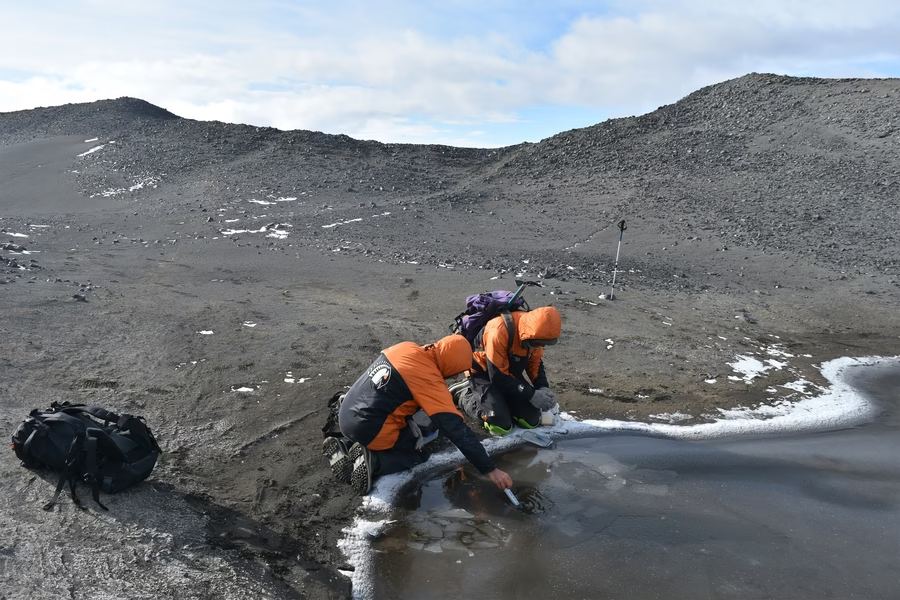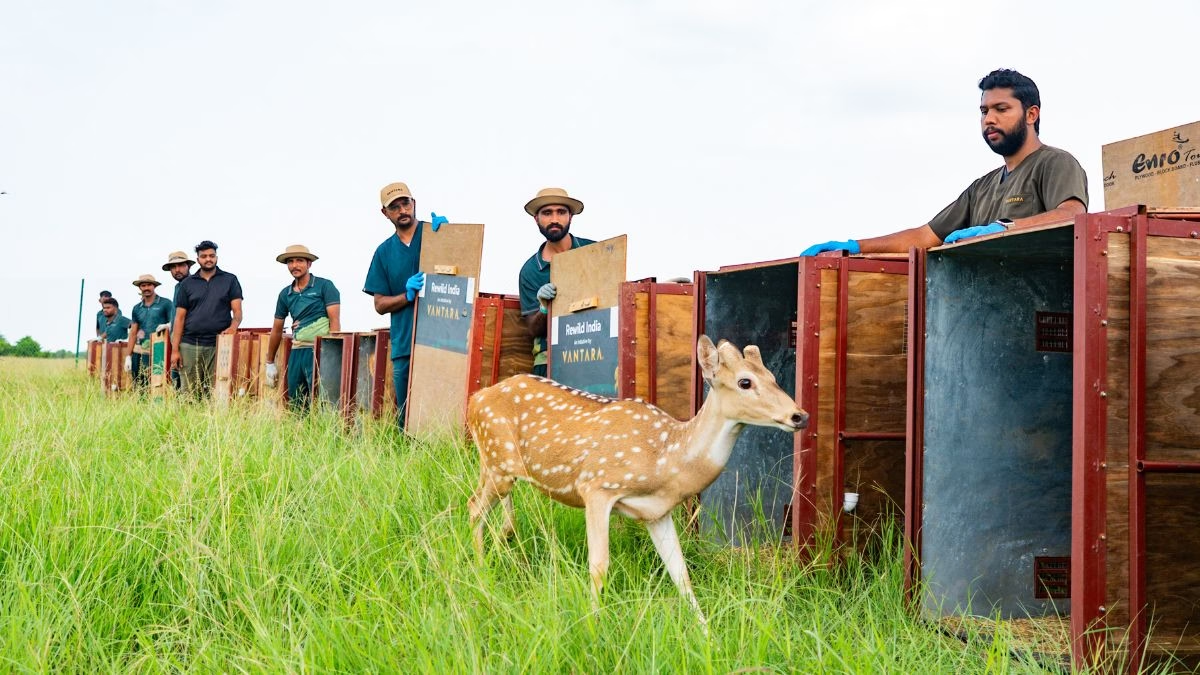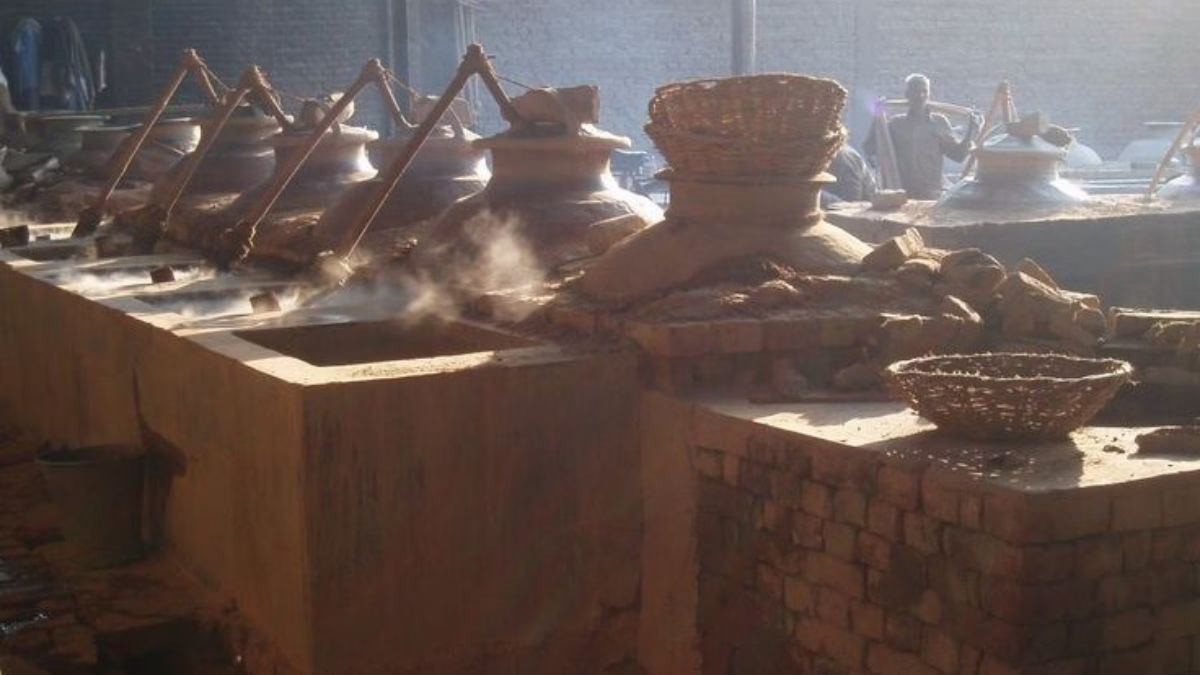Earth
Meltwater ponds might have sheltered life during earth’s deep freeze
During this time, the planet was believed to be encased in ice, with global temperatures plummeting to as low as -50°C

In a study published in Nature Communications, scientists from MIT have proposed that shallow meltwater ponds may have provided critical refuges for early complex life during one of Earth’s most extreme ice ages — the “Snowball Earth” period, which occurred between 635 and 720 million years ago.
During this time, the planet was believed to be encased in ice, with global temperatures plummeting to as low as -50°C. Despite the harsh conditions, complex cellular life — known as eukaryotes — managed to survive. The new research suggests that these life forms could have found sanctuary in small, briny pools formed on the surface of equatorial ice sheets.
“Meltwater ponds are valid candidates for where early eukaryotes could have sheltered during these planet-wide glaciation events,” said lead author Fatima Husain, a graduate researcher in MIT’s Department of Earth, Atmospheric and Planetary Sciences, in a media statement. “This shows us that diversity is present and possible in these sorts of settings. It’s really a story of life’s resilience.”
The team drew parallels between ancient equatorial ice sheets and modern Antarctic conditions. They studied contemporary meltwater ponds on Antarctica’s McMurdo Ice Shelf — an area first dubbed “dirty ice” by explorers in the early 20th century. These ponds, formed by sun-warmed dark debris trapped within surface ice, provided a modern analog to the possible melt environments of the Cryogenian Period.
Samples taken from these Antarctic ponds revealed clear signatures of eukaryotic life. Using chemical and genetic analysis, including the identification of sterols and ribosomal RNA, the researchers detected algae, protists, and microscopic animals — all descendants of early eukaryotes. Each pond supported unique communities, with differences shaped largely by salinity levels.
“No two ponds were alike,” Husain noted. “There are repeating casts of characters, but they’re present in different abundances. We found diverse assemblages of eukaryotes from all the major groups in all the ponds studied.”
These findings suggest that meltwater ponds — overlooked in previous hypotheses — could have served as vital “above-ice oases” for survival and even diversification during Snowball Earth.
“There are many hypotheses for where life could have survived and sheltered during the Cryogenian, but we don’t have excellent analogs for all of them,” Husain explained. “Above-ice meltwater ponds occur on Earth today and are accessible, giving us the opportunity to really focus in on the eukaryotes which live in these environments.”
The study was co-authored by MIT’s Roger Summons, Thomas Evans (formerly MIT), Jasmin Millar of Cardiff University, Anne Jungblut of the Natural History Museum in London, and Ian Hawes of the University of Waikato in New Zealand.
By uncovering how life may have persisted through Earth’s frozen past, the research not only deepens understanding of our planet’s history — it may also help inform the search for life on icy worlds beyond Earth.
Earth
Spotted Deer Introduced in Gujarat’s Banni Grasslands, India to Aid Biodiversity Restoration
The translocation, conducted in collaboration with the wildlife conservation initiative Vantara, is part of an effort to enhance biodiversity in one of Asia’s largest and most fragile grassland ecosystems

In a move aimed at supporting ecological restoration in the Banni Grasslands, Gujarat, India, the State Forest Department has introduced 20 spotted deer into a protected 70-hectare area within the landscape. The translocation, conducted in collaboration with the wildlife conservation initiative Vantara, is part of an effort to enhance biodiversity in one of Asia’s largest and most fragile grassland ecosystems. Vantara is a wildlife conservation initiative founded by Anant Ambani, a board member of Reliance Industries, one of India’s largest conglomerates. Vantara operates the Greens Zoological, Rescue and Rehabilitation Centre in Jamnagar, which served as the source facility for the spotted deer.
The spotted deer, also known as chital (Axis axis), were translocated from Vantara’s ex-situ conservation facility in Jamnagar. They were moved in specially designed ambulances and released under the direct supervision of the Forest Department. Vantara provided logistical and veterinary support to ensure adherence to conservation protocols during the process.
The Banni Grasslands, stretching over 2,600 sq. km in Gujarat’s Kutch district, are a unique arid ecosystem that supports a range of wildlife. According to regional biodiversity surveys, 12 species of mammals have been recorded in the area, including six carnivores such as the Indian wolf and striped hyena, and two herbivores, including the Indian gazelle.
Forest officials and experts from Vantara jointly conducted a field assessment ahead of the deer release to evaluate habitat conditions and inform future rewilding strategies. The review included ecological suitability checks and outlined key habitat restoration measures.
Dr. Brij Kishor Gupta, Director of the Greens Zoological, Rescue and Rehabilitation Centre under Vantara, noted the importance of science-driven collaboration in the effort.
“This initiative reflects a collaborative approach to conservation, where scientific expertise and logistical support are combined to strengthen biodiversity in the Banni Grasslands. Contributing to government-led efforts, the focus remains on achieving meaningful conservation outcomes through partnerships grounded in shared objectives.”

The Gujarat Forest Department has been working to manage ecological pressures in Banni through habitat restoration, control of invasive species, and promotion of native grass growth—critical to sustaining herbivore populations and the carnivores that depend on them.
While the introduction of spotted deer is a notable milestone, experts emphasize that such rewilding interventions must be closely monitored. Ecologists point out that herbivore populations can influence vegetation dynamics, and the long-term impact on the grassland’s carrying capacity and predator-prey relationships remains to be studied.
For now, the project marks a rare instance of coordinated public-private conservation action in India’s grasslands—ecosystems often overshadowed by forests and wetlands in national conservation discourse. As such, it could serve as a model for future wildlife restoration efforts in similar landscapes.
Earth
How Barn Owls Brought Nature, Knowledge, and Heart to a South African Campus
At the University of the Free State, South Africa, a quiet conservation story unfolds above the bookshelves – reminding us that even academic spaces can grow wings.

High above the rows of books and hushed reading tables of the Sasol Library at the University of the Free State (UFS), something unexpected is taking flight. A pair of barn owls have made their home in the library’s roof, quietly raising their young and shifting the way an entire academic community sees its role in the world. Their story, both poetic and practical, is becoming a symbol of collaboration, compassion, and conservation.
The owls aren’t just guests—they’re catalysts. What began as a distressed bird outside the library in 2023 has transformed into a university-wide initiative blending science, storytelling, and shared stewardship.
“Our library is a living ecosystem”
For Prof Vasu Reddy, Deputy Vice-Chancellor: Research and Internationalisation, the owls are more than a charming anecdote.
“If we consider Shakespeare’s play, All’s Well That Ends Well, then the presence of the owls in the Sasol Library confirms another meaning of that play,”
“Love,” Prof Reddy says, “is not always considered noble, but is something persistent, and our library is not just a building, but a living ecosystem where precious documents, people, and even animals can interact, shape, and nurture our lives.”

That idea—that libraries are not only homes to knowledge, but habitats for life—is now echoed across campus.
A rescue that became a movement
The turning point came when Tanya Scherman, from the Centre for Teaching and Learning, spotted a sick owl near the library—likely a victim of secondary poisoning from a contaminated rodent.
“It appeared that the owl had been poisoned,” she recalls. “I phoned around trying to find more knowledgeable people who could help.”
Her outreach brought in a network of allies, including the Owl Rescue Centre in Pretoria, a local vet, and Prof Francois Deacon from the Department of Animal Sciences.
“As someone passionate about urban wildlife conservation, I saw a great opportunity – not just to support the owls, but to involve students in hands-on learning,” says Prof Deacon.
Together with his postgraduate students, Ruan Higgs and Kaitlyn Taylor, the team designed a custom nesting box and installed a motion-activated infrared camera to monitor owl activity safely. For Scherman, building the box was a family affair.
“I worked with my dad to build it,” she shares. “He’s an avid animal lover too… It was such a special moment to share with my family.”
From research to relationships
The project has already yielded tangible outcomes. In 2023, the owl pair successfully raised two owlets. This year, six eggs were laid—three owlets are visible so far.

“It captures feeding events, chick development, and parental behaviour,” says Prof Deacon. “This kind of passive monitoring is invaluable… These owls are teaching tools.”
Their footage has already formed the basis for student research on owl diet, nesting habits, and ecological adaptation. And the benefits go beyond science.
“What’s been most rewarding was how many people came together around this – from librarians to students to scientists. We built friendships, not just a nest box.”
Even librarian Hesma van Tonder joined a giraffe capture excursion with Deacon’s team. These moments, Deacon says, are where research and real-life adventure meet.
Symbols of wisdom – and survival
For Scherman, the owls touch something deeper than academic interest.
“My grandparents also had a special connection to owls… When we saw the baby owlets, I naturally felt like I was being promoted to an owl-granny!”
She also hopes to change cultural perceptions around these often-misunderstood birds.
“It’s understandable,” she says, “with their eerie calls, white faces, and ghost-like flight. But they are also messengers, protectors, and symbols of wisdom in many traditions.”
From reducing rodent populations naturally to serving as symbols of coexistence, barn owls bring both ecological and educational value.
“A single owl pair can eat hundreds of rodents in a breeding season,” says Prof Deacon. “We found remains of small birds and insects in their regurgitated pellets… which shows just how active and adaptive they are in an urban environment.”
But risks remain—road traffic, noise, and poisoning threaten their safety. That’s why Scherman and Deacon urge the campus community to be mindful.
“Don’t try to help an injured owl yourself,” says Scherman. “Rather contact Prof Deacon or me… We’re here to assist.”
“Awareness builds respect,” Prof Deacon adds. “Simple behaviours, such as keeping windows closed at night near the roost, go a long way.”
Where silence meets storytelling
As word spread, the initiative grew in meaning—turning the Sasol Library into more than a study space. It’s now a symbol of the university’s values in action.
“It is clear that what may be seen as a disruptive incident with an owl swooping into our library space is also a pedagogical and deeply conservation touchdown,” reflects Prof Reddy.
“Our barn owl event tells us that our library is also a space where silence meets storytelling… where every creature’s story has a rightful place.”
Looking forward
The team is already dreaming bigger. Deacon hopes to expand the project into green corridors, rooftop biodiversity zones, and support for species like bats and pollinators. He sees it as the start of a new kind of campus culture—one rooted in curiosity and care.
“If our university matters and is to remain meaningful,” Prof Reddy says, “our accidental visitors have given new impetus to the fact that our library space holds our stories, and they are making places for new ones as part of our responsible societal futures.”
As the owls continue their quiet vigil above the Sasol Library, they leave more than pellets behind. They leave a legacy of connection—between people, nature, and the pursuit of knowledge. And in that space, where a library became a nest, a new kind of learning has taken flight.
Earth
In ancient India, mushy earth made for perfume scent
Kannauj, a city in the Indian state of Uttar Pradesh, offers a sustainable alternative in producing perfumes using traditional modes of distillation.

A sweet scent typically lingers around in the air at Kannauj, an ancient city in India’s most populous state of Uttar Pradesh. It’s an imprint of the countless occasions when it had rained, of roses that bloomed at dawn, and of sandalwood trees that once breathed centuries of calm.. Though mushy smells are not unique to Kannauj, the city utilized traditional distillation methods to make perfume out of these earthly scents.
Kannauj has had a longstanding tradition in perfume-making since four centuries ago. The city, colloquially known as the country’s ancient perfume capital, still uses rustic copper stills, wood-fired ovens, and bamboo pipes leading to sandalwood oil-filled vessels, or attar as it is colloquially known, to make their perfume. Though it gives a pre-industrial look, a closer peek would reveal an ecosystem of complex thermal regulation, plant chemistry, sustainability science, and hydro-distillation chemistry at work.
When synthetically-made but sustainable perfumes, and AI-generated ones share the spotlight today, Kannauj’s tryst with perfumes offer an alternative, sustainable model in traditional distillation, which is inherently low-carbon, zero-waste, and follow principles of a circular economy; all in alignment with sustainable development goals.
Traditional perfume-making is naturally sustainable
In industrial processing, hydro-distillation is a commonly done to separate substances with different boiling points. Heating the liquids produce vapors, which can later be liquefied in a separate chamber. Perfumers in Kannauj follow the same practice, except it promises to be more sustainable with the copper stills, a process colloquially known as dheg-bhakpa hydro-distillation.
There’s no alcohol or synthetic agents in use. Instead, they heat up raw botanicals – such as roses, vetiver roots, jasmine, or even sunbaked clay – to precise temperatures well short of burning, thereby producing fragrant vapor. The vapors are then guided into cooling chambers, where they condense and bond with a natural fixative, often sandalwood oil. Plant residue is the only byproduct, which finds use as organic compost to cultivate another generation of crops.

Trapping earthly scent to make perfume
In the past five years, Kannauj’s veteran perfumers noticed a quiet, but steady shift in their timely harvest and produce. Rose harvests have moved earlier by weeks. Vetiver roots grow shallower due to erratic rainfall. Jasmine yields are fluctuating wildly. The local Ganges river, which influences humidity levels essential for distillation timing, is no longer as predictable. For an entire natural aromatic economy built on seasonal synchrony, this uncertainty has rung alarm bells.
“The scent of a flower depends not just on the flower itself,” Vipin Dixit, a third-generation attar-maker whose family has distilled fragrance for decades, said to EdPublica.
“It depends on the weather the night before, on the heat at sunrise, on the moisture in the air. Even the soil has a scent-memory.”

As a result, perfumers in Kannauj have begun to adapt, applying traditional wisdom through a modern scientific lens. Local distillers are now working with botanists and environmental scientists to study soil microbiomes, measure scent compounds using chromatography, and develop community-based rainwater harvesting to ensure sustainable crop health.
One of the most surprising innovations is trapping petrichor — the scent of first rain — through earth attars. Clay is baked during extreme heat waves, mimicking summer conditions, then distilled to trap the scent of rain hitting dry soil. This aroma, called mitti attar, is one of the few scents in the world created from an environmental phenomenon; and not a flower.
At a time when the world is scrambling to save biodiversity, the humble attar may become a template for green chemistry — one that doesn’t just preserve scent, but also restores the relationship between science, nature, and soul.
-

 Society6 months ago
Society6 months agoStarliner crew challenge rhetoric, says they were never “stranded”
-

 Space & Physics5 months ago
Space & Physics5 months agoCould dark energy be a trick played by time?
-

 Women In Science5 months ago
Women In Science5 months agoNeena Gupta: Shaping the Future of Algebraic Geometry
-

 Space & Physics5 months ago
Space & Physics5 months agoSunita Williams aged less in space due to time dilation
-

 Know The Scientist6 months ago
Know The Scientist6 months agoMysterious, resilient, and radiant: The timeless legacy of Marie Curie
-

 Earth4 months ago
Earth4 months ago122 Forests, 3.2 Million Trees: How One Man Built the World’s Largest Miyawaki Forest
-

 Interviews6 months ago
Interviews6 months agoDr. Saji Kumar Sreedharan’s Quest to Restore Memory in Aging and Disease
-

 Learning & Teaching5 months ago
Learning & Teaching5 months agoHow Understanding Individual Learning Styles Can Transform Education



















